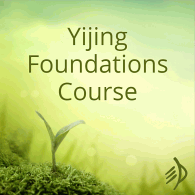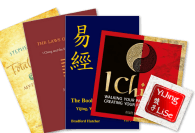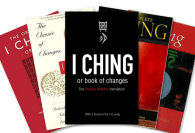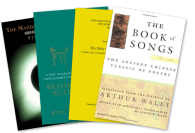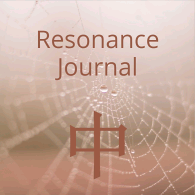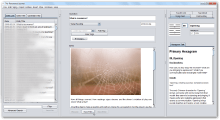I almost titled this post ‘working with trigrams’ – but the most useful, productive ways I know of to engage with trigrams in readings actually feel a lot more like play. And besides, who needs more work?
So here’s how I suggest you start playing. (This is really not a comprehensive guide! That would be book-sized – and once you start playing, you can write your own book.)
First – what not to do
Don’t forget about trigrams altogether! This is easily done, especially when you’re just getting started with the Yijing. Trigrams make for a convenient chart to look up your hexagram, and then you read the words… and then if you get back to trigrams at all, it’s as something of an afterthought, an optional extra.
You can do useful readings this way, hear things you need to hear… but it can all get a bit cerebral, ungrounded – and unmemorable. You can end up fixating on single words of translation – or worse, of commentary – and losing your sense of how this all works in the hexagram(s) as a whole.
And on the other hand – don’t get sucked into treating this as some sort of hierarchy, where you’re not a real expert until you can do without the text altogether. Yes, you could do readings without ever opening the book. Likewise, a close friend could probably communicate quite a lot to you in mime, and it could be fun to try this and see how far you get. But if your aim is actually to understand your friend fully, why wouldn’t you let them speak to you as well?
(And sticking with this analogy for a moment – anyone who’s engaged in any kind of online communication knows how much it can suffer for lack of body language and tone of voice. That’s like a reading with no awareness of hexagram structure – no trigrams, no hexagram shape, no line positions.)
Secondly, don’t start with a list of trigram attributes and treat interpretation as a pair of ‘fill in the blanks’ exercises: inner world = [pick a word from the list]; outer world = [pick a word from the list].
Why not? Trigram lore is vast and fascinating, after all, and opens up applications you might never find with just the text.
For one thing, picking isolated words from a list is arid and mechanical, which never makes for good readings. If you go straight to ‘what does it mean?’ and miss out any experience of the imagery, you’re not engaging with the oracle at all.
Also, you’re more or less bound to end up picking out properties to suit what you want, consciously or not. (Yes, this is a potential trap with any interpretation – we all do it – but it’s a whole lot easier to fall into this way than with – say – a complete scenario or story, such as the text might offer you.)
And if you’re picking an application for one trigram at a time, what about the relationship between the trigrams? They don’t just sit inert on top of one another like bricks; they interact.
What to do (or how to begin)
(These are just first steps, to get underway and open up more possibilities. Rule 1 of Yijing interpretation: there is always more!)
To start with, see what picture the two trigrams paint when you look at them together. A trigram embodies a way of moving and relating, so what it’s relating to makes a difference. (For some examples of how this works, you could browse through the ‘light inside‘ series of posts, about li, fire/light, as inner trigram.) You can use whatever trigram associations you’re familiar with to paint your pictures, but you don’t need a lot of specialist knowledge: simply their images from nature (sky, earth, thunder, water, mountain…) will give you plenty of ideas.
Take Hexagram 39, Limping: water above, mountain below.
What does water above a mountain look like?
There’s more than one thing you could imagine here, and no ‘right answer’. (Engaging your imagination and dreaming up your own picture is part of the interpretation process.) You might imagine a rainstorm shrouding the summit, or a stream flowing over rocks.
Last autumn, I found myself walking through Hexagram 39, tromping up a steep hill in the rain, watching the water rushing down round my (wet) feet. The clouds rose, the rain fell, and the streams flowed. And then I thought – hm – what does water do, when it’s up a mountain? Answer: it flows down. Only humans insist on going up.
And that connects immediately with the text: the clouds rose, then the rain falls; it turns round. The same turnaround is in the oracle – the 180 degree turn between south-and-west and north-and-east – and in each of the lines that contrasts going and coming. But my experience of squelching up the hill while the water flowed down doesn’t just give me insight into the text, it gives me a feel for it. That’s what stays with you.
Of course, some trigrams don’t so readily form pictures. Hexagram 11, Flow, has heaven below earth –
– which is beyond my imaginary painter, anyway. With these, it helps to think about how each trigram moves, or what they do. Heaven moves ceaselessly, it rises (ever gazed into the sky and had that sense of falling upward?); earth is still, and sinks down. And remember how energy ‘wants’ to move up through a hexagram, from inside to outside. Then you have, maybe not quite a picture, but something like a diagram: creative heaven-energy rising, infusing the spaces of the earth and bringing it all to life.
This way of seeing is a bit harder – or rather, it’s only easy when you’re more familiar with trigrams. Most I Ching books will have some commentary that gets you started.
You may find you can also understand a lot just by looking at the shape of the trigrams and feeling your way in. Solid lines are energetic and full; open lines are empty space. How do these feel – especially, how do the first three lines of your hexagram feel as you’re casting them, as an inner state? Inner kan, running water, often feels to me like butterflies in the stomach. Inner gen, mountain, feels solid and still.
And then how could that tip over into the outer trigram’s way of moving or being? (In Hexagram 39, you could feel irreducibly robust, inwardly, but still find ways to flow like water.)
All this is really a non-verbal way of connecting with your hexagram – not ‘making sense of’ it, not even necessarily understanding it, but internalising it, so the experience becomes vivid and immediate. Then the understanding you derive from the words (not least words about the trigrams) will be more visceral, and more memorable.
And just to reiterate – you’re not looking for the right answer, only for the experience of connection. Trigrams will feel different for different people, and in different hexagrams, and on different days.
Even if this is all sounding a bit remote, you can always trust the Image – that part of the text that names the hexagram’s component trigrams and then tells you what the noble one (or sometimes the ancient kings) will do. The more I read this, the more respect I have for its authors. (See also – ‘The genius of the Daxiang‘.)
Only do bear in mind that the Image is advice. The noble one is demonstrating an ideal response to those trigram energies. It’s not a prediction, and not even necessarily a promise that you’ll be able to attain this ideal – more of a model and aspiration.
